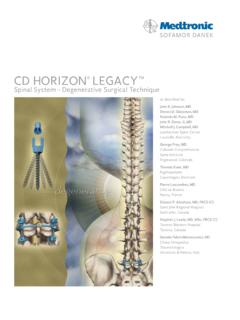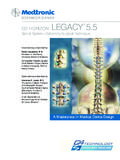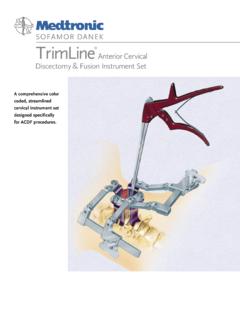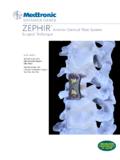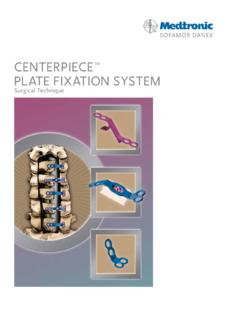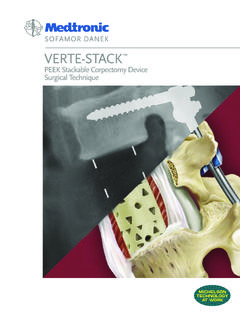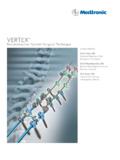Transcription of CAPSTONE PEEK Spinal System - MT Ortho
1 CAPSTONE PEEKS pinal SystemPLIF and TLIFS urgical TechniqueAs described by:Charles Branch, Jr., MDProfessor of Neurosurgery Wake Forest UniversityBaptist Medical CenterWinston-Salem, North CarolinaKevin Foley, MDProfessor of NeurosurgerySemmes-Murphy ClinicNeurologic and Spine Instituteand University of TennesseeMemphis, TennesseeAnthony Salerni, MDNeurosurgeryLakes Regional HospitalLaconia, New HampshireCAPSTONE PEEKS pinal SystemPLIF and TLIFS urgical TechniqueImplant and Instrument Set Features 2 Instrument Set 3X-ray Marker Location 4 Implant Sizing 5 TLIF: Open and MAST TechniquesLaminotomy and Facetectomy 7 Disc Space Preparation 8 Distraction 9 End-plate Preparation 10 Trial Insertion 11 CAPSTONE PEEK Interbody Spacer Insertion 12 Final Placement 13 Navigation and Neuromonitoring Options 14 Additional Fixation Options 15 Explantation 15 PLIF: Open and MAST TechniquesLaminotomy and Facetectomy 17 Disc Space Preparation 18 Distraction 19 End-plate Preparation 20 Trial Insertion 21 CAPSTONE PEEK Interbody Spacer Insertion 22 Final Placement 23 Navigation and Neuromonitoring Options 24 Additional Fixation Options.
2 25 Explantation 25 Product Ordering Information 26 Important Product Information 27 CAPSTONE PEEK Spinal System PLIF and TLIF | Surgical Technique2 CAPSTONE PEEK Spinal System PLIF and TLIF | Surgical Techniqueimplant and instrument Set FeaturesImplant Set FeaturesInstrument Set Features Self-distracting, bulleted tip Convex-shaped Implants are designed to fit patient anatomy and to allow more accurate sizing Teeth on the surface reduce likelihood of expulsion Posterior Lumbar Interbody Fusion (PLIF) or Transforaminal Lumbar Interbody Fusion ( TLIF) procedural solutions combining CAPSTONE Instrument Set, Posterior Microscope Instrument (PMI)
3 Set, SCISSOR JACK Distractor, METRx System , CD HORIZON SEXTANT II Rod Insertion System , PYRAMETRIX Advance Instrument Set or the CD HORIZON ENGAGE Spinal System Distractor/Trials are designed with bullet-tip shape for self-distraction and ease of insertion Convex-shaped Trials are designed to fit patient anatomy and to allow more accurate sizing Compatible with open, mini-open, or MAST technique approachesCAPSTONE PEEK Spinal System PLIF and TLIF | Surgical TechniqueCAPSTONE PEEK Spinal System PLIF and TLIF | Surgical Technique3instrument SetDistractor/Trial2980822 Distractor/Trial2981032 Threaded Inserter2980001 Slap Hammer9074002 CAPSTONE PEEK Spinal System PLIF and TLIF | Surgical Technique4 CAPSTONE PEEK Spinal System PLIF and TLIF | Surgical TechniqueX-ray Marker location Below are diagrams demonstrating the location of the x-ray markers as the view is rotated from a lateral to a straight AP LocationsLateralObliqueStraight APCAPSTONE PEEK
4 Spinal System PLIF and TLIF | Surgical TechniqueCAPSTONE PEEK Spinal System PLIF and TLIF | Surgical Technique5implant SizingImplant SizingLengthHeightInternal = 10mmTLIF: Open and MAST TechniquesCAPSTONE PEEK Spinal System PLIF and TLIF | Surgical TechniqueCAPSTONE PEEK Spinal System PLIF and TLIF | Surgical Technique7laminotomy and FacectomyA facetectomy is performed on the ipsilateral side. Using an osteotome or drill, remove the ascending and descending articular bony removal may be carried out using a Kerrison rongeur or 1cm-square annulotomy is made with a scalpel in Kambin s triangle.
5 The disc is removed using a pituitary rongeur and curettes. The main goal of this step is to remove extruded fragments, decompress neural elements and provide entry into the disc space for distraction, with minimal or no nerve root retraction. If there is significant disc space collapse, a complete discectomy may not be possible until disc space distraction is complete. DiscectomyOpen TLIF TechniqueMAST TLIF TechniqueCAPSTONE PEEK Spinal System PLIF and TLIF | Surgical Technique8 CAPSTONE PEEK Spinal System PLIF and TLIF | Surgical TechniqueDisc Space PreparationOpen TLIF TechniqueMAST TLIF Technique Remove disc using the Rotate Cutter.
6 The instruments are blunt tipped and side cutting for PEEK Spinal System PLIF and TLIF | Surgical TechniqueCAPSTONE PEEK Spinal System PLIF and TLIF | Surgical Technique9 DistractionOpen TLIF TechniqueMAST TLIF TechniqueInsert supplemental screw and rod fixation on the contralateral side to maintain distraction during disc space preparation and provisionally tighten the disc space is sequentially distracted with a Distractor/Trial or the SCISSOR JACK Distractor until adequate disc space height is obtained and adequate foraminal size is the SCISSOR JACK Distractor is used, insert the distractor with the curved sides touching the end plates and expand the distractor until the desired height is PEEK Spinal System PLIF and TLIF | Surgical Technique10 CAPSTONE PEEK Spinal System PLIF and TLIF | Surgical Techniqueend-plate PreparationMAST TLIF TechniqueSpecifically designed angled instruments allow disc resection and end-plate TLIF TechniqueCAPSTONE PEEK Spinal System PLIF and TLIF | Surgical TechniqueCAPSTONE PEEK Spinal System PLIF and TLIF | Surgical Technique11 Trial insertionOpen TLIF TechniqueMAST TLIF TechniqueInsert the Distractor/Trial
7 Until the desired disc space height is established. Use AP and lateral fluoroscopy to confirm proper placement and ViewCAPSTONE PEEK Spinal System PLIF and TLIF | Surgical Technique12 CAPSTONE PEEK Spinal System PLIF and TLIF | Surgical TechniquecaPSTOne PeeK interbody Spacer insertionOpen TLIF TechniqueMAST TLIF TechniqueThe appropriately sized CAPSTONE PEEK Interbody Spacer is chosen during the trialing step and is firmly attached to the inserting the interbody spacer, place autograft anteriorly and contralaterally, or in the interbody spacer central impact the CAPSTONE PEEK Interbody Spacer until it is 3mm to 4mm below the posterior margin of the should be taken to ensure the interbody spacer is aligned PEEK Spinal System PLIF and TLIF | Surgical TechniqueCAPSTONE PEEK Spinal System PLIF and TLIF | Surgical Technique13 Final PlacementOpen TLIF TechniqueMAST TLIF Technique After the CAPSTONE PEEK Interbody Spacer is placed, the contralateral screw-rod construct is compressed to preload the interspace and restore lordosis.
8 The extradural space and foramina are probed to ensure adequate decompression of the neural facilitate satisfactory immobilization of the grafted interspace, segmental fixation is applied ipsilaterally using the standard ViewCAPSTONE PEEK Spinal System PLIF and TLIF | Surgical Technique14 CAPSTONE PEEK Spinal System PLIF and TLIF | Surgical Techniquenavigation and neuromonitoring OptionsNavigation OptionThe FluoroNav MAST Spinal Procedural Solution can provide assistance with pedicle navigation. An additional module containing all of the necessary attachments is required for using the FLUORONAv MAST Spinal Procedural OptionFor neuromonitoring, a NIM PAK Needle or Pedicle Probe may be used to access the pedicle.
9 Triggered EMG monitoring can be performed during advancement of the needle into the pedicle to ensure proper PEEK Spinal System PLIF and TLIF | Surgical TechniqueCAPSTONE PEEK Spinal System PLIF and TLIF | Surgical Technique15additional Fixation Options and explanationsThe CD HORIZON LEGACY System Set Screws (plugs) may be removed using the T27 Obturator and the Self-Retaining Breakoff Driver. The T27 Obturator is inserted into the working end of the Self-Retaining Breakoff Driver so that the knurled portion of the T27 Obturator is flush with the driver. Insert the T27 Obturator tip through the Counter Torque, which should be seated on the screw, and into the plug, turning counterclockwise until the plug has been removed.
10 The pedicle screws may be removed using either the multi-axial Screwdriver or the Self-Retaining Screwdriver in connection with the Ratcheting Handle. First, attach the Ratcheting Handle to the modular end of the driver. Next, fully engage the hex end of the Screwdriver into the screw head, then, if using the multi-axial screwdriver, thread the instrument sleeve into the screw head. Turn counterclockwise until the pedicle screws have been removal of a CD HORIZON X10 CROSSLINK MULTI-SPAN Plate is necessary, place the 7/ " torque-limiting set screwdriver over the midline nut and turn counterclockwise to loosen.
